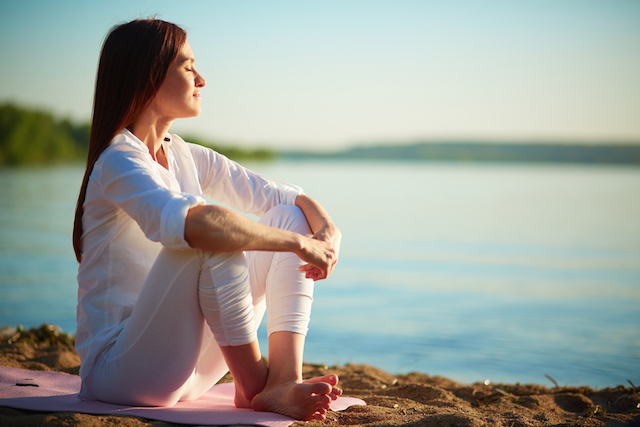How Mindfulness Combats Anxiety
The word anxiety gets thrown out all the time, but what does it actually feel like? Is it really that big of a deal? And how can it be effectively addressed and contained so that it doesn’t dominate our lives?
Anxiety is intense, persistent worry about every day situations, such as public speaking, an upcoming performance review, or an important event or decision. It is the body’s natural response to stress and everyone has felt anxiety at some point in their lives. You know you feel anxious when your thoughts are fixed on worry and your body typically displays the following symptoms:
- Racing heartbeat
- Rapid or shallow breathing
- Sweating
- Fatigue
- Clenched muscles or jaw
- Inability to clear your mind and focus
When Anxiety Becomes a Problem
While everyone feels anxious at some point in their lives, some people feel consistently and firmly held in its grip. When anxiety feels all-consuming, uncontrollable, or when it impacts your daily life, it can be a sign of an underlying issue. This can be the result of going through an intensely trying season of life, such as a divorce or a bankruptcy, the result of trauma, or a disorder as described by the 5th Diagnostic and Statistical Manual (DSM 5), which is used to diagnose mental health issues.
Whatever the underlying reasons behind anxiety, the feeling of anxiety and its impact to our bodies is significant. Intense, long-term stress and anxiety can cause increased health issues, emotional instability, relational issues, and the attempt to cope in unhealthy ways like isolation, eating, or self-medicating.

What Helps Anxiety?
There are numerous approaches to help curb anxiety and they may vary from person to person. Some of the common treatments include:
- Medication
- Talk therapy
- Journaling
- Exercise
- Self-Care
- Regulation Tools
The Importance of Regulation
When anxiety rules over us, we are often at the mercy of our limbic system. The amygdala is the part of the limbic system that senses danger and rings our internal alarm bells to alert us to react. When this happens, it sets off a chain of events that include an entire body response, which is where you see the increased heart rate, rapid breathing, shakiness, and more.
What’s more, when the limbic system is triggered, the blood flows more to the vital organs required for survival and away from other places like the neocortex. This is important because the neocortex is our rational, executive, thinking brain. If there is not adequate blood flow to our neocortex, we are not able to think clearly. This produces the confusion and brain fog one sometimes feels with anxiety. It also explains why we get so freaking angry when someone tells us to simply “calm down” as we are not able to respond to verbal interactions as well during this time.
So what does help?
When we are fully present in the moment, not ruminating on the past and not worrying about the future, but completely present and aware, we are typically able to identify that there is no immediate threat. We are able to regain control of our breathing, relax as our heart rate slows, release the tension in our bodies, and take in all the sights, smells, sounds, and other immediate sensory stimuli. We can then reframe some of our distorted thoughts and tackle the others individually.
This is called mindfulness and it is vital to combat anxiety.
When we are fully present in the moment, allowing thoughts to come and go, continually bringing ourselves back to the immediate moment, taking in everything our senses reveal, breathing gently, relaxing our body, and incorporating anything that aids our sensory efforts (ie. soft music, essential oils, a weighted blanket, etc.), it is impossible for the limbic system to be hyper-aroused.

“It Doesn’t Work”
Some people say that breathing and mindfulness don’t work for them. While it is true that certain self-regulation tools will work better for some than others, most people have the ability to be present. It’s just that the longer we’ve spent time in anxiety and survival mode, the longer it takes to develop the practice. It can be frustrating at first. Be patient with yourself.
Where To Start
There are a lot of tools that can help us begin the practice of mindfulness. First, apps like Calm and Abide (yes, both are paid; no, they don’t sponsor us) are accessible on your phone and provide numerous opportunities for mindfulness, soothing sounds, sleep stories, and more. Second, YouTube has plenty of videos specific to mindfulness as well as ambient sounds with visually appealing backgrounds to provide background and allow you to guide yourself. Third, if you have an Alexa or Google Home, there are options on those devices, as well. Finally, simply getting out into nature is helpful to a lot of people when it comes to quieting all the noise and being able to just appreciate their surroundings.
Try several things and make several attempts. Five minutes is plenty to begin with. Accomplishing small moments of mindfulness is incredibly helpful to building our toolkits and lessening the intensity and control of anxiety in our lives.
If you have anxiety, PTSD, or ruminating thoughts, we would love to hear if you struggle with mindfulness, if you try it successfully, or what has worked for you.

